The fully automatic trimming and forming system market is expected to expand from USD 108.8 million in 2025 to USD 178.8 million by 2035, at a CAGR of 5.1%, with regional growth led by semiconductor packaging intensity, automation readiness, and electronics manufacturing concentration. Asia Pacific dominates adoption, driven by China at 6.9% and India at 6.4%, where semiconductor packaging clusters, large-scale electronics assembly bases, and government automation incentives accelerate deployment of precision trimming and forming platforms. High-volume IC packaging operations and expanding SMT ecosystems strengthen demand for high-precision systems integrated with advanced motion control and vision inspection. Europe, anchored by Germany at 5.9%, reflects a precision-focused market where established electronics manufacturing and strong quality norms drive adoption of high-accuracy forming platforms across semiconductor packaging and component fabrication. The UK, France, Italy, and Spain add steady momentum through industrial electronics operations, automation upgrades, and component manufacturing requirements. Eastern Europe and Nordic economies begin transitioning from semi-automated setups to advanced forming systems as production moves toward higher-tolerance environments.
North America, led by the USA at 4.8%, maintains stable adoption driven by advanced semiconductor packaging development, defense electronics manufacturing, and strong automation integration capabilities. Fully automatic systems gain traction in facilities where cycle time efficiency, dimensional uniformity, and quality traceability shape procurement decisions. Latin America, with Brazil at 5.4%, gains momentum through expanding electronics manufacturing footprints and rising demand for dimensional precision in component processing. Japan, growing at 3.8%, reinforces high-precision adoption rooted in advanced automation culture and deep semiconductor packaging capability, prioritizing systems with exceptional positioning accuracy, repeatability, and process stability.

The market demonstrates strong momentum across established and emerging electronics manufacturing economies, where semiconductor packaging industries are transitioning from semi-automated methods to fully automated systems that offer superior performance characteristics and operational efficiency. Fully automatic trimming and forming technology addresses critical manufacturing challenges including consistent dimensional accuracy maintenance in high-volume production, process repeatability requirements in complex component geometries, and quality consistency across extended production runs.
The semiconductor industry shift toward advanced packaging technologies including system-in-package and multi-chip modules creates sustained demand for precision equipment capable of processing miniaturized components with minimal variation and consistent quality output. Electronics manufacturers are adopting fully automatic systems for component processing where dimensional accuracy directly impacts assembly reliability and product performance requirements. The technology capability to produce components with excellent dimensional consistency reduces secondary inspection operations and accelerates production workflows.
Between 2025 and 2030, the fully automatic trimming and forming system market is projected to expand from USD 108.8 million to USD 132.7 million, resulting in a value increase of USD 23.9 million, which represents 34.1% of the total forecast growth for the decade. This phase of development will be shaped by rising demand for automated semiconductor packaging solutions in electronics manufacturing, product innovation in precision control technology and vision inspection systems, as well as expanding integration with advanced production automation platforms and quality management systems. Companies are establishing competitive positions through investment in advanced motion control systems, high-precision positioning technologies, and strategic market expansion across semiconductor packaging facilities, electronic assembly plants, and specialized component manufacturing operations.
From 2030 to 2035, the market is forecast to grow from USD 132.7 million to USD 178.8 million, adding another USD 46.1 million, which constitutes 65.9% of the overall ten-year expansion. This period is expected to be characterized by the expansion of specialized automation systems, including advanced machine vision capabilities and intelligent process control configurations tailored for specific component types and dimensional requirements, strategic collaborations between equipment manufacturers and semiconductor packaging companies, and an enhanced focus on processing accuracy optimization and throughput enhancement. The growing emphasis on manufacturing efficiency and quality consistency will drive demand for advanced, high-performance fully automatic trimming and forming solutions across diverse semiconductor packaging applications.
| Metric | Value |
|---|---|
| Market Value (2025) | USD 108.8 million |
| Market Forecast Value (2035) | USD 178.8 million |
| Forecast CAGR (2025-2035) | 5.1% |
The fully automatic trimming and forming system market grows by enabling manufacturers to achieve superior component dimensional accuracy and processing throughput while reducing labor costs in precision semiconductor packaging operations. Manufacturing facilities face mounting pressure to improve production efficiency and component quality, with fully automatic systems typically providing consistent processing accuracy and throughput rates exceeding manual and semi-automated methods, making these specialized systems essential for competitive electronics manufacturing operations. The semiconductor packaging and electronics assembly industries need for precise component processing creates demand for advanced automated solutions that can maintain tight tolerances, achieve excellent repeatability, and ensure consistent dimensional accuracy across diverse component types and production volumes.
Industrial automation initiatives promoting production line integration and lights-out manufacturing drive adoption in semiconductor packaging facilities, electronic assembly operations, and specialized component fabrication, where processing efficiency has a direct impact on throughput capacity and manufacturing costs. The global shift toward miniaturization principles and Industry 4.0 implementation accelerates fully automatic trimming and forming system demand as electronics facilities seek automation solutions that minimize operator intervention and maximize equipment utilization. Limited awareness of optimal system configuration and higher initial capital costs compared to semi-automated equipment may limit adoption rates among small-scale electronics manufacturers and regions with traditional manufacturing practices and limited automation expertise and technical support infrastructure.
The market is segmented by type, application, and region. By type, the market is divided into standard precision type, high precision type, and others. Based on application, the market is categorized into semiconductor packaging plant and electronic assembly plant. Regionally, the market is divided into Asia Pacific, Europe, North America, Latin America, and Middle East & Africa.
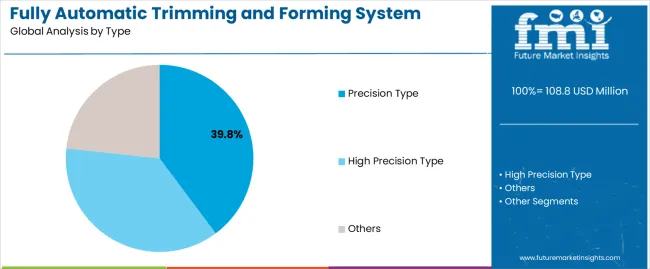
The precision type segment represents the dominant force in the fully automatic trimming and forming system market, capturing approximately 39.8% of total market share in 2025. This category encompasses standard precision configurations optimized for general semiconductor packaging requirements, delivering consistent dimensional accuracy and reliable processing performance across diverse component types. The precision type segment market leadership stems from its balanced design architecture, cost-effective automation solutions, and compatibility with standard production line infrastructures across semiconductor packaging facilities and electronic assembly operations.
The high precision type segment maintains a substantial 36.2% market share, serving manufacturers who require superior dimensional accuracy through advanced vision systems, enhanced motion control capabilities, and specialized processing configurations that deliver exceptional repeatability in critical component applications.
Key advantages driving the precision type segment include:
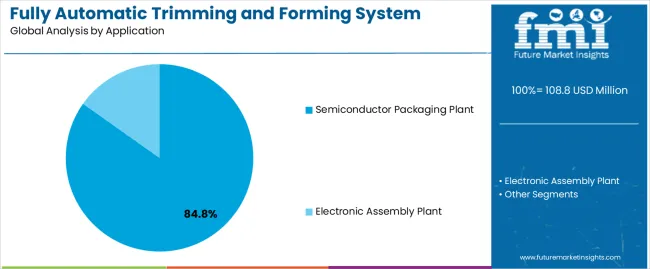
Semiconductor packaging plant applications dominate the fully automatic trimming and forming system market with approximately 84.8% market share in 2025, reflecting the extensive adoption of automated processing solutions across integrated circuit packaging operations, discrete semiconductor manufacturing, and specialized component fabrication facilities. The semiconductor packaging plant segment market leadership is reinforced by widespread implementation in advanced package processing, chip carrier fabrication, and precision component finishing operations, which provide essential productivity advantages and quality consistency in high-volume production environments.
The electronic assembly plant segment represents 15.2% market share through specialized applications including component preparation operations, precision forming requirements, and quality-critical assembly processes where dimensional accuracy impacts final product performance and reliability.
Key market dynamics supporting application preferences include:
The market is driven by three concrete demand factors tied to manufacturing efficiency and quality outcomes. First, semiconductor industry expansion creates increasing requirements for automated processing solutions, with global semiconductor production facilities requiring reliable fully automatic trimming and forming systems for advanced packaging operations, chip carrier fabrication, and precision component manufacturing. Second, electronics miniaturization trends and stringent quality requirements drive adoption of precision automation technology, with fully automatic systems improving dimensional accuracy consistency while reducing processing variations in semiconductor packaging applications. Third, industrial automation initiatives and production line integration accelerate deployment across electronics facilities, with fully automatic trimming and forming systems integrating seamlessly into automated production lines and enabling lights-out manufacturing capabilities in high-volume production environments.
Market restraints include initial investment barriers affecting small-scale electronics manufacturers and cost-sensitive production operations, particularly where semi-automated methods remain adequate for less demanding applications and where capital budgets constrain adoption of advanced automation systems. Technical integration requirements for production line implementation pose adoption challenges for facilities lacking automation expertise, as fully automatic system performance depends heavily on proper integration with existing equipment, process parameter optimization, and quality control systems that vary significantly across production environments. Limited availability of application-specific technical support in emerging electronics manufacturing markets creates additional barriers, as production facilities require specialized training in system operation procedures, troubleshooting methods, and maintenance practices to achieve target performance levels.
Key trends indicate accelerated adoption in Asian electronics manufacturing hubs, particularly China and India, where semiconductor packaging operations and electronics assembly capabilities are expanding rapidly through government industrialization programs and foreign direct investment in manufacturing infrastructure. Technology advancement trends toward intelligent vision systems with enhanced inspection capabilities, optimized motion control algorithms for improved processing accuracy, and modular system architectures enabling rapid configuration changes are driving next-generation product development. The market thesis could face disruption if alternative component processing technologies achieve breakthrough capabilities in automated handling systems, potentially reducing demand for traditional trimming and forming operations in specific application segments.

| Country | CAGR (2025-2035) |
|---|---|
| China | 6.9% |
| India | 6.4% |
| Germany | 5.9% |
| Brazil | 5.4% |
| USA | 4.8% |
| UK | 4.3% |
| Japan | 3.8% |
The fully automatic trimming and forming system market is gaining momentum worldwide, with China taking the lead thanks to aggressive semiconductor manufacturing expansion and industrial automation programs. Close behind, India benefits from growing electronics assembly operations and government manufacturing initiatives, positioning itself as a strategic growth hub in the Asia-Pacific region. Brazil shows strong advancement, where expanding electronics production facilities and manufacturing infrastructure development strengthen its role in South American electronics supply chains. The USA demonstrates robust growth through advanced semiconductor packaging initiatives and electronics sector investment, signaling continued adoption in precision automation applications. Meanwhile, Japan stands out for its precision manufacturing expertise and advanced automation technology integration, while UK and Germany continue to record consistent progress driven by electronics manufacturing facilities and industrial equipment production. Together, China and India anchor the global expansion story, while established markets build stability and technology leadership into the market growth path.
The report covers an in-depth analysis of 40+ countries; with top-performing countries highlighted below.
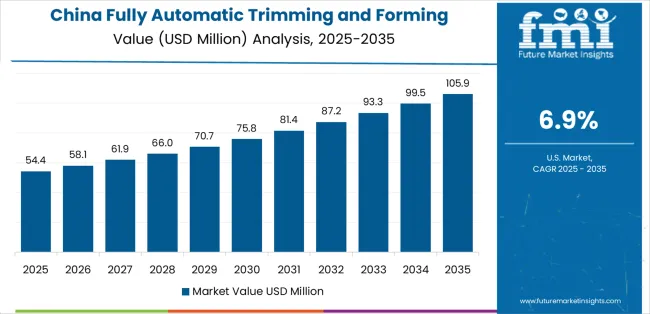
China demonstrates the strongest growth potential in the Fully Automatic Trimming and Forming System Market with a CAGR of 6.9% through 2035. The country leadership position stems from comprehensive semiconductor manufacturing expansion, intensive electronics industry development programs, and aggressive industrial automation targets driving adoption of advanced processing technologies. Growth is concentrated in major electronics manufacturing regions, including Guangdong, Jiangsu, Zhejiang, and Shanghai, where semiconductor packaging facilities, electronics assembly operations, and component manufacturing plants are implementing fully automatic trimming and forming systems for productivity enhancement and quality improvement. Distribution channels through industrial equipment distributors, automation specialists, and direct manufacturer relationships expand deployment across semiconductor clusters, electronics production bases, and precision component manufacturing centers. The country Made in China 2025 initiative provides policy support for advanced manufacturing technology adoption, including subsidies for automation equipment implementation and manufacturing upgrading programs.
Key market factors:
In the National Capital Region, Karnataka, Tamil Nadu, and Maharashtra electronics zones, the adoption of fully automatic trimming and forming systems is accelerating across semiconductor packaging facilities, electronics assembly operations, and component manufacturing plants, driven by Make in India initiatives and increasing focus on manufacturing competitiveness. The market demonstrates strong growth momentum with a CAGR of 6.4% through 2035, linked to comprehensive electronics sector expansion and increasing investment in automation capabilities. Indian manufacturers are implementing fully automatic trimming and forming technology and advanced processing platforms to improve production efficiency while meeting stringent quality requirements in semiconductor packaging and electronics assembly operations serving domestic and export markets. The country National Manufacturing Policy creates sustained demand for advanced automation solutions, while increasing emphasis on production efficiency drives adoption of precision processing systems that enhance manufacturing productivity.
Germany advanced electronics manufacturing sector demonstrates sophisticated implementation of fully automatic trimming and forming systems, with documented case studies showing significant productivity improvements in semiconductor packaging operations through optimized automation strategies. The country manufacturing infrastructure in major industrial regions, including Bavaria, Baden-Wurttemberg, North Rhine-Westphalia, and Saxony, showcases integration of precision automation technologies with existing production facilities, leveraging expertise in electronics manufacturing and component fabrication. German manufacturers emphasize quality standards and process optimization, creating demand for reliable fully automatic solutions that support productivity commitments and stringent dimensional accuracy requirements. The market maintains strong growth through focus on Industry 4.0 integration and manufacturing excellence, with a CAGR of 5.9% through 2035.
Key development areas:
The Brazilian market leads in Latin American fully automatic trimming and forming system adoption based on expanding electronics manufacturing operations and growing production infrastructure in major industrial centers. The country shows solid potential with a CAGR of 5.4% through 2035, driven by electronics sector investment and increasing domestic demand for precision-manufactured components across consumer electronics, automotive electronics, and industrial equipment sectors. Brazilian manufacturers are adopting fully automatic trimming and forming technology for compliance with electronics industry quality standards, particularly in component processing requiring precise dimensional tolerances and in production operations where automation efficiency impacts manufacturing economics. Technology deployment channels through industrial distributors, equipment representatives, and financing programs expand coverage across electronics supply chains and component manufacturing facilities.
Leading market segments:
The USA market leads in advanced fully automatic trimming and forming system applications based on integration with sophisticated production automation platforms and comprehensive manufacturing systems for enhanced production efficiency. The country shows solid potential with a CAGR of 4.8% through 2035, driven by semiconductor packaging expansion and increasing adoption of advanced automation technologies across electronics manufacturing, defense electronics, and industrial equipment production sectors. American manufacturers are implementing fully automatic trimming and forming systems for high-precision processing requirements, particularly in advanced semiconductor packaging demanding tight tolerances and in electronics production where cycle time reduction directly impacts manufacturing economics. Technology deployment channels through industrial distributors, automation specialists, and direct manufacturer relationships expand coverage across diverse electronics operations.
Leading market segments:
The UK market demonstrates consistent implementation focused on electronics component manufacturing and specialized production operations, with documented integration of fully automatic trimming and forming systems achieving productivity improvements in component processing operations. The country maintains steady growth momentum with a CAGR of 4.3% through 2035, driven by electronics manufacturing presence and precision component requirements in advanced electronics applications. Major industrial regions, including South East England, East Midlands, and Scotland, showcase deployment of advanced automation technologies that integrate with existing manufacturing infrastructure and support quality requirements in electronics supply chains.
Key market characteristics:
Japan fully automatic trimming and forming system market demonstrates sophisticated implementation focused on semiconductor packaging operations and precision electronics manufacturing, with documented integration of advanced automation systems achieving cycle time reduction in high-precision component processing operations. The country maintains steady growth momentum with a CAGR of 3.8% through 2035, driven by manufacturing excellence culture and emphasis on process optimization principles aligned with lean manufacturing philosophies. Major industrial regions, including Tokyo, Osaka, Aichi, and Kyushu, showcase advanced deployment of precision automation technologies that integrate seamlessly with automated production lines and comprehensive quality control systems.
Key market characteristics:
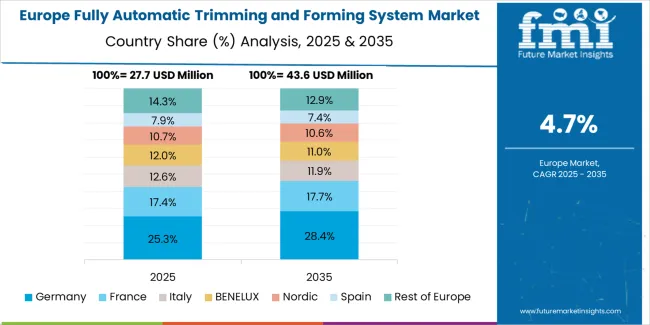
The fully automatic trimming and forming system market in Europe is projected to grow from USD 28.4 million in 2025 to USD 51.2 million by 2035, registering a CAGR of 6.0% over the forecast period. Germany is expected to maintain its leadership position with a 34.2% market share in 2025, declining slightly to 33.5% by 2035, supported by its extensive electronics manufacturing infrastructure and major industrial centers, including Bavaria, Baden-Wurttemberg, and North Rhine-Westphalia production regions.
France follows with a 19.5% share in 2025, projected to reach 19.8% by 2035, driven by comprehensive electronics component production and precision manufacturing programs in major industrial regions. The United Kingdom holds a 16.3% share in 2025, expected to reach 16.6% by 2035 through electronics manufacturing facilities and precision component operations. Italy commands a 12.8% share in both 2025 and 2035, backed by electronics production and machinery manufacturing. Spain accounts for 7.4% in 2025, rising to 7.6% by 2035 on electronics assembly operations and manufacturing sector growth. The Rest of Europe region is anticipated to hold 9.8% in 2025, expanding to 10.3% by 2035, attributed to increasing fully automatic trimming and forming system adoption in Nordic countries and emerging Central & Eastern European electronics manufacturing operations.

The Japanese fully automatic trimming and forming system market demonstrates a mature and quality-focused landscape, characterized by sophisticated integration of precision automation systems with existing semiconductor packaging infrastructure across component production operations, electronics manufacturing, and precision assembly facilities. Japan emphasis on manufacturing excellence and process optimization drives demand for precision automation equipment that supports quality commitments and productivity targets in competitive manufacturing environments.
The market benefits from strong partnerships between international equipment providers and domestic industrial distributors including major trading companies, creating comprehensive service ecosystems that prioritize technical support and application engineering programs. Industrial centers in Tokyo, Osaka, Aichi, and other major manufacturing areas showcase advanced electronics implementations where fully automatic trimming and forming systems achieve high dimensional accuracy compliance through optimized processing parameters and comprehensive quality control systems.
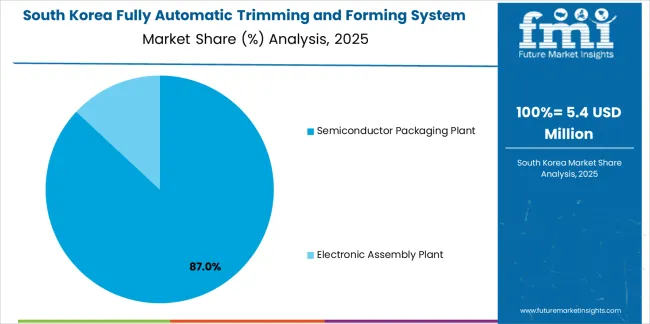
The South Korean fully automatic trimming and forming system market is characterized by growing international technology provider presence, with companies maintaining significant positions through comprehensive technical support and application engineering capabilities for semiconductor packaging operations and precision electronics manufacturing applications. The market demonstrates increasing emphasis on manufacturing automation and productivity enhancement, as Korean manufacturers increasingly demand advanced processing solutions that integrate with domestic production infrastructure and sophisticated automation management systems deployed across major industrial complexes.
Regional equipment distributors are gaining market share through strategic partnerships with international manufacturers, offering specialized services including technical training programs and application-specific automation solutions for semiconductor and electronics production operations. The competitive landscape shows increasing collaboration between multinational equipment companies and Korean industrial specialists, creating hybrid service models that combine international product development expertise with local technical support capabilities and rapid response systems.
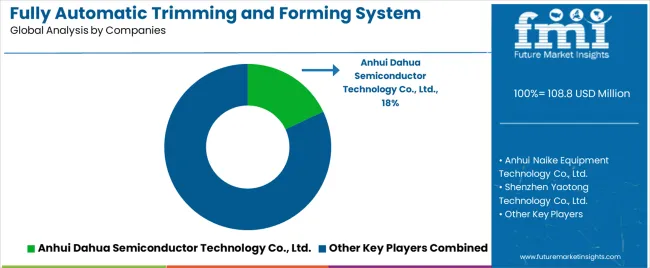
The fully automatic trimming and forming system market features approximately 15-20 meaningful players with moderate fragmentation, where leading companies control market share through established distribution networks and comprehensive product portfolios. Competition centers on processing accuracy consistency, system reliability, and technical support capabilities rather than price competition alone. Market leaders maintain competitive advantages through specialized automation technology and established relationships with semiconductor packaging facilities and electronics manufacturers.
Market leaders include equipment manufacturers with global reach and advanced automation capabilities, which maintain competitive advantages through technical expertise, automation system integration capabilities, and deep application knowledge across multiple electronics sectors, creating trust and reliability advantages with semiconductor packaging operations and electronic assembly facilities. These companies leverage research and development capabilities in vision system optimization, motion control technology advancement, and ongoing technical support relationships to defend market positions while expanding into emerging electronics manufacturing markets and specialized application segments.
Challengers encompass regional equipment manufacturers and automation specialists, which compete through specialized product offerings and strong regional presence in key electronics manufacturing markets. Product specialists focus on specific system configurations or application segments, offering differentiated capabilities in custom automation solutions, rapid delivery services, and competitive pricing structures for standard configurations.
Regional players and emerging automation equipment manufacturers create competitive pressure through localized manufacturing advantages and rapid response capabilities, particularly in high-growth markets including China and India, where proximity to semiconductor packaging clusters provides advantages in technical support responsiveness and customer relationships. Market dynamics favor companies that combine proven processing performance with comprehensive application engineering offerings that address the complete automation cycle from system integration through process optimization and quality assurance.
Fully automatic trimming and forming systems represent advanced automation solutions that enable manufacturers to achieve consistent dimensional accuracy and processing throughput while reducing labor requirements, delivering superior component quality and manufacturing productivity with enhanced repeatability and process consistency in demanding semiconductor packaging applications. With the market projected to grow from USD 108.8 million in 2025 to USD 178.8 million by 2035 at a 5.1% CAGR, these precision automation systems offer compelling advantages - productivity enhancement, quality improvement, and operational efficiency - making them essential for semiconductor packaging plant applications (84.8% market share), electronic assembly plant operations (15.2% share), and manufacturing facilities seeking alternatives to semi-automated methods that compromise productivity through higher labor requirements and inconsistent quality. Scaling market adoption and technology deployment requires coordinated action across industrial policy, manufacturing infrastructure development, equipment manufacturers, electronics production facilities, and industrial automation investment capital.
| Item | Value |
|---|---|
| Quantitative Units | USD 108.8 million |
| Type | Standard Precision Type, High Precision Type, Others |
| Application | Semiconductor Packaging Plant, Electronic Assembly Plant |
| Regions Covered | Asia Pacific, Europe, North America, Latin America, Middle East & Africa |
| Country Covered | China, India, Germany, Brazil, USA, UK, Japan, and 40+ countries |
| Key Companies Profiled | Anhui Dahua Semiconductor Technology Co., Ltd., Anhui Naike Equipment Technology Co., Ltd., Shenzhen Yaotong Technology Co., Ltd., Guangdong Taijin Semiconductor Technology Co., Ltd., Semipower Technology (Dongguan) Co., Ltd., Guoxin Intelligence, Zhuoer Semiconductor Equipment (Suzhou) Co., Ltd., Mepgroup, ASMPT SEMI Solution, Shenzhen Tianwei Electronics Co., Ltd. |
| Additional Attributes | Dollar sales by type and application categories, regional adoption trends across Asia Pacific, Europe, and North America, competitive landscape with automation equipment manufacturers and distribution networks, manufacturing facility requirements and specifications, integration with automated production lines and quality control systems, innovations in vision system technology and motion control platforms, and development of specialized automation solutions with enhanced processing accuracy and throughput capabilities. |
The global fully automatic trimming and forming system market is estimated to be valued at USD 108.8 million in 2025.
The market size for the fully automatic trimming and forming system market is projected to reach USD 178.9 million by 2035.
The fully automatic trimming and forming system market is expected to grow at a 5.1% CAGR between 2025 and 2035.
The key product types in fully automatic trimming and forming system market are precision type , high precision type and others.
In terms of application, semiconductor packaging plant segment to command 84.8% share in the fully automatic trimming and forming system market in 2025.






Our Research Products

The "Full Research Suite" delivers actionable market intel, deep dives on markets or technologies, so clients act faster, cut risk, and unlock growth.

The Leaderboard benchmarks and ranks top vendors, classifying them as Established Leaders, Leading Challengers, or Disruptors & Challengers.

Locates where complements amplify value and substitutes erode it, forecasting net impact by horizon

We deliver granular, decision-grade intel: market sizing, 5-year forecasts, pricing, adoption, usage, revenue, and operational KPIs—plus competitor tracking, regulation, and value chains—across 60 countries broadly.

Spot the shifts before they hit your P&L. We track inflection points, adoption curves, pricing moves, and ecosystem plays to show where demand is heading, why it is changing, and what to do next across high-growth markets and disruptive tech

Real-time reads of user behavior. We track shifting priorities, perceptions of today’s and next-gen services, and provider experience, then pace how fast tech moves from trial to adoption, blending buyer, consumer, and channel inputs with social signals (#WhySwitch, #UX).

Partner with our analyst team to build a custom report designed around your business priorities. From analysing market trends to assessing competitors or crafting bespoke datasets, we tailor insights to your needs.
Supplier Intelligence
Discovery & Profiling
Capacity & Footprint
Performance & Risk
Compliance & Governance
Commercial Readiness
Who Supplies Whom
Scorecards & Shortlists
Playbooks & Docs
Category Intelligence
Definition & Scope
Demand & Use Cases
Cost Drivers
Market Structure
Supply Chain Map
Trade & Policy
Operating Norms
Deliverables
Buyer Intelligence
Account Basics
Spend & Scope
Procurement Model
Vendor Requirements
Terms & Policies
Entry Strategy
Pain Points & Triggers
Outputs
Pricing Analysis
Benchmarks
Trends
Should-Cost
Indexation
Landed Cost
Commercial Terms
Deliverables
Brand Analysis
Positioning & Value Prop
Share & Presence
Customer Evidence
Go-to-Market
Digital & Reputation
Compliance & Trust
KPIs & Gaps
Outputs
Full Research Suite comprises of:
Market outlook & trends analysis
Interviews & case studies
Strategic recommendations
Vendor profiles & capabilities analysis
5-year forecasts
8 regions and 60+ country-level data splits
Market segment data splits
12 months of continuous data updates
DELIVERED AS:
PDF EXCEL ONLINE
Fully Sealed Fully Insulated Inflatable Cabinet Market Size and Share Forecast Outlook 2025 to 2035
Fully Enclosed Cartons Market Size and Share Forecast Outlook 2025 to 2035
Fully Enclosed 3D Printing Smart Warehouse Market Size and Share Forecast Outlook 2025 to 2035
Fully Integrated Dishwasher Market Size and Share Forecast Outlook 2025 to 2035
Fully Automated Coagulometer Market
Fully Automatic Blood Gas Analyzer Market Size and Share Forecast Outlook 2025 to 2035
Fully Automatic Blood Cell Analyzer Market Size and Share Forecast Outlook 2025 to 2035
Fully Automatic Wet Chemical Analyzers Market Size and Share Forecast Outlook 2025 to 2035
Fully Automatic Hydraulic Lifting Column Market Size and Share Forecast Outlook 2025 to 2035
Fully Automatic High Speed Nail Making Machine Market Size and Share Forecast Outlook 2025 to 2035
Fully Automatic Solid-Liquid Purge Trap Market Size and Share Forecast Outlook 2025 to 2035
Fully Automatic Liquid Metal Printing Machines Market Size and Share Forecast Outlook 2025 to 2035
Fully Automatic Silver Sintering System Market Size and Share Forecast Outlook 2025 to 2035
Automatic Chicken Deboning Machine Market Size and Share Forecast Outlook 2025 to 2035
Automatic Filter Press Solutions Market Size and Share Forecast Outlook 2025 to 2035
Automatic Filter Presses (AFPs) Market Size and Share Forecast Outlook 2025 to 2035
Automatic Riveting Equipment Market Forecast and Outlook 2025 to 2035
Automatic Weigh Price Labeling Machine Market Size and Share Forecast Outlook 2025 to 2035
Automatic Bending Machine Market Size and Share Forecast Outlook 2025 to 2035
Automatic Transmission Market Size and Share Forecast Outlook 2025 to 2035

Thank you!
You will receive an email from our Business Development Manager. Please be sure to check your SPAM/JUNK folder too.
Chat With
MaRIA